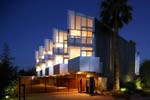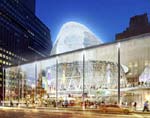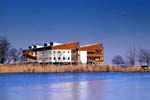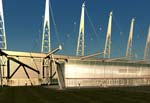
|
|
|
|
 |
|
Home Site Search Contact Us Subscribe
|
|
|
|
Green Design as Great Design: The Architecture of Sustainability
A design competition and conference seek to merge technical ingenuity and compelling design. by Kyle Copas February 28, 2006 “The Architecture of Sustainability” conference coming up May 4-7, co-sponsored by the American Institute of Architects (AIA) Committee on Design (CoD) and Committee on the Environment (COTE), promises to open new forms of dialogue between design excellence and environmental innovation, and marks an unprecedented collaboration between the two committees. “The combination creates a perfect synergy,” remarks Greg Mella, AIA, LEED, one of the conference co-chairs and a COTE representative. “Sustainability enriches design just as much as design enriches sustainability.”
Green, Vitruvius or Est Viridis?
The conference evolved out of separate events held by the groups last year; the conference steering committee includes current CoD chair David Brems, AIA, CoD advisory group member David Greenbaum, FAIA, and Lance Hosey, AIA, LEED, of COTE. The cross-committee cooperation also reflects their belief that the combined concerns of CoD and COTE comprise entire architectural agenda: is it durable, is it useful, and is it beautiful?
Sea Ranch, the setting for last year’s CoD conference, brought issues of sustainability into sharp relief. “It’s arguably the only sustainable building among the AIA’s 25-Year Award winners,” Brems remarks. In July, discussions at the AIA’s green building summit in Washington turned toward the architect’s role in sustainability. “Like it or not, designers often distinguish between the science of building and the art of architecture,” says Hosey. “In recent years the construction industry has done a great job of raising the level of debate about the science, but what of the art? Regardless of how efficiently we use resources, if design doesn’t inspire people, it will not last. If we get it right, sustainable design promises to bring art and science together.”
By treating green design as a cultural and an architectural concern rather than a solely technical matter – “the junior chemistry set of methods and materials,” they joke – the organizers hope that “The Architecture of Sustainability” will create fresh ideas about the ethical and aesthetic implications of design. The speaker list, which includes Will Bruder, AIA; Jeanne Gang, AIA, Edward Mazria, AIA, and Grimshaw’s Andrew Whalley, AIA, among others, embodies the merger of technical ingenuity and compelling design.
House and Home
An important piece of the puzzle is the competition being held in conjunction with the conference. “House for an Ecologist” (registration deadline: March 17) will build on the success of CoD’s 2004 New Home on the Range competition which expanded the committee’s outreach efforts toward younger participants. The current competition challenges designers to develop a residence for a fictitious Ecologist in Residence at the National Conservation Training Center in Shepherdstown, West Virginia – the site for two days of the four-day conference.
The exercise’s straightforward site and program emphasizes non-technical approaches to sustainable design and enables entrants, in Hosey’s words, “to get to the form quickly.” COTE’s Top Ten Measures for Sustainable Design, developed as the basis for the AIA’s annual green building awards program, serves as a loose guide for the competition. This approach encourages architects to consider such guidelines as a driver for design and not just a tool for evaluating performance after the fact. The competition jury – Peter Bohlin, FAIA, Bohlin Cywinski Jackson; Allison Ewing, AIA, LEED, Hays + Ewing Design Studio; Susan Szenasy, Editor, Metropolis magazine; and James Timberlake, FAIA, LEED, KieranTimberlake Associates – speaks precisely to this combination of aesthetic and ecological integrity.
Process of Evolution
Both the competition and the conference anticipate the need for architects to adapt to changes in the design process that alter the traditional role of the designer as a singular visionary. At a conference planning session Mella noted, “We have great design ideas coming from engineers,” after which the others laughingly expressed the need to suppress this bit of apostasy. “Let’s not get carried away,” Greenbaum admonished.
Brems cited one of his projects as testimony to the strength of integrated design. The goal for the Utah Olympic Oval, site of the 2002 Olympic speed skating events, was to create the world’s fastest sheet of ice. Working within a tight not-to-exceed budget, the design team recognized that creating ideal conditions for athletes required an unprecedented level of climate control. As they studied how to minimize the volume of the building to the greatest extent possible, project engineers at ARUP evaluated several possible structural designs. In the typical course of events, the most expensive option – a cable suspension system only three feet deep – would have been discarded, but the benefits it brought to the mechanical system and a reduction in the amount of steel required led to a surprising conclusion: the lowest cost building was the one with the most expensive structural system.
Experiences like this, not to mention the ones that lie ahead at the conference and with the competition, offer only an initial glimpse of the insights required to “make green an inboard aesthetic,” as Greenbaum describes it. By beginning to change the premises of the discussion and chart the shifts in attitude over time, “The Architecture of Sustainability” could change how designers think of green building.
Kyle
Copas is a writer and
documentary film maker in Charlottesville, Virginia, where he has
been Director of Communications at William McDonough + Partners since 2001.
MORE INFORMATION
“House for an Ecologist” Registration deadline March 17; entries due March 31 http://www.aia.org/br_cfe_cod_ideascomp06
“The Architecture of Sustainability” May 4-7, 2006, Washington, DC, and Shepherdstown, WV http://www.aia.org/ev_cod_may06
PROGRAM SPONSORS American Institute of Architects Committee on Design (CoD) Committee on the Environment (COTE)
COMPETITION JURY Peter Bohlin, FAIA Bohlin Cywinski Jackson Wilkes-Barre, PA Allison Ewing, AIA, LEED Hays + Ewing Design Studio Charlottesville, VA Susan Szenasy Metropolis magazine New York, NY James Timberlake, FAIA, LEED KieranTimberlake Associates Philadelphia, PA
COMPETITION ORGANIZERS / CONFERENCE CO-CHAIRS CoD David Brems, AIA Gillies Stransky Brems Smith Salt Lake City, UT David Greenbaum, FAIA SmithGroup Washington, DC COTE Lance Hosey, AIA, LEED ATMO / Atelier Modern Washington, DC Greg Mella, AIA, LEED SmithGroup Washington, DC AIA staff Kathleen Lane Project Manager, AIA CoD |
(click on pictures to enlarge)  (Will Bruder Architects) Will Bruder Architects: Loloma 5 Residence, Scottsdale, AZ (KieranTimberlake Associates) KieranTimberlake Associates: Loblolly House, Taylor’s Island, Chesapeake Bay, MD (Studio/Gang/Architects) Studio/Gang/Architects: “Best Nest,” Ford/Calumet Environmental Center, Calumet, IL (Grimshaw) Grimshaw: Fulton Street Transit Center, New York, NY (Bohlin Cywinski Jackson) Bohlin Cywinski Jackson, Ballard Library and Neighborhood Service Center, Seattle Public Library, Seattle, WA  (SmithGroup) SmithGroup: Chesapeake Bay Foundation, Philip Merrill Environmental Center, Annapolis, MD (Gillies Stransky Brems Smith) Gillies Stransky Brems Smith: Oquirrh Park Oval, Kearns, UT (ATMO / Atelier Modern) ATMO / Atelier Modern: “Eco-Loo,” New York, NY |
© 2006 ArchNewsNow.com